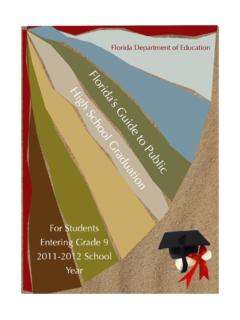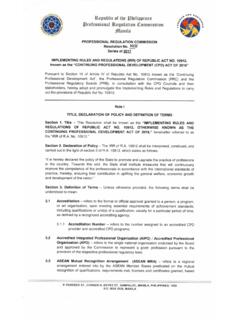Transcription of Cameroon - Education Facts Sheet - HALI Access Network
1 Education FACT Sheet - Cameroon In Brief SUMMARY Population: million (Word Bank, 2016) Country Size: 475,442 sq km/183,442 sq mi National Curricula: Yes, with the French and English Sub-systems of Education Literacy: (Knoema, 2015) Youth Literacy: (Knoema, 2015) Female Youth Literacy: (Knoema, 2015) Years of Public School: 13 Primary: 6 years, starting age 5 Secondary School (Ordinary Level): 5 years [4 years in the technical and French Sub-System] High School (Advanced Level): 2 [3 years in the technical and French Sub-System] Language of Instruction: English, French High School Leaving Exams: The GCE Advanced Level, the Baccalaureat Date of Exams: May-June Education Overview Trending toward English Cameroon has two educational sub-systems operating simultaneously: one based on its British colonial past and the other on its French colonial past.
2 More Cameroonians are embracing studies in English, following the globalization trend. Free Primary, Subsidized Secondary Education In government schools, primary Education became free for all children in Cameroon in the year 2000 but parents pay minimal Parent-Teacher Association (PTA) levies. The government is the largest provider of primary Education . In the cities, the number of privately-owned primary schools is rising they charge very high fees for higher quality Education , involving ICT. Secondary/high school Education is equally highly subsidized by the government of Cameroon and many households are able to afford it.
3 There are many private and prestigious mission secondary/high schools which charge more. Students who can afford them or those who do not gain admission into government secondary/high schools resort to the mission/private institutions. The percentage of students advancing to the Ordinary Level and the number of students attending universities has increased significantly as a result of the government s policy of creating schools in every neighborhood and at least a university in each region of the country. Within the last ten years, more public institutions of higher learning have been created.
4 Cameroon s Education Expenditure % of GDP (World Bank, 2013) Pupil/Teacher Ratio: 46:1 (Open Data for Africa, 2012) % Entering primary school having attended preschool (UNESCO, 2016) % Completing primary school % (UNESCO, 2016) % Transition to secondary school (UNESCO, 2015) % Completion of secondary school % (World Bank, 2015) Number of candidates who took the GCE Advanced Level Exams in 2016: 46,714 Number of candidates who took the Baccalaureat (Francophones) in 2016: 103,097 Total number of candidates who took the high school exams in 2016: 149, 811 [This number excludes those who took the GCE technical Exams - statistics still being sought.]
5 ] % Completion of Advanced Level studies 40% Boys, 32 % Girls (EPDC, 2014) % Achieving pass grades at the A Level exams % ( Cameroon GCE Board A L 2016) State-owned Universities: 8 [two Anglo-Saxon] Other Higher Institutions of Learning: 201 University enrollment rates in Cameroon have increased by 22% over the past 20 years (World Bank 2018) School System Progression not Automatic Cameroonian Education can be described as follows: 2 years optional pre-school from age 3 or 5 6 years in basic primary Education (for children aged 5-11) 5 years of secondary Education (ages 11-16) 2 years of high school Education (ages 16-20) NB: The elementary level classes are known as primary, while the secondary ones are known as forms and the high school ones are known as lower and upper sixth forms.
6 Progression from one educational level to another is not automatic as it depends on national examination results, overseen by the government at the end of Class 6 in the primary, Form 5 in the secondary and Upper Sixth Form in the high school, overseen by the Cameroon GCE Board and the Cameroon BACC Board (for secondary and high school). The Government Common Entrance exam for pupils in class 6 allows for the rationing of the limited space available in government schools by pushing out children who do not achieve a pass in list A to seek admission in non-government secondary schools.
7 With so many newly created government secondary schools, these standards however are being compromised. Grading Systems The grading system in Cameroon for the GCE Ordinary and Advanced Level results is based on exam letter grades. a. Letter Grades/points awarded (i) GCE Advanced Level Grade Marks Points Remark A 80-100 5 Excellent B 4 Very Good C 3 Good D 2 Average E 1 Satisfactory 0 Compensatory F 0 Fail The mark boundaries are not standardized and often depend on the general performance. A student must have at least two subjects to be declared successful at the GCE Advanced Level.
8 (ii) GCE Ordinary Level Grade Marks Points Remark A 75-100 3 Excellent B 2 Very Good C 1 Good D 0 Failed E 0 Failed U 0-15 0 Useless The mark boundaries are not standardized and often depend on the general performance. A student must have at least four subjects to be declared successful at the GCE Ordinary Level. b. Cumulative Grade Scale Students are allowed to sit a maximum of 5 subjects at the GCE Advanced Level and 11 at the Ordinary Level. Hence a student can have 15 points and 33 points maximum at the Advanced and Ordinary Level GCE respectively.
9 In the 2016 GCE, the distribution was as follows Number of Points No. of Students GCE Ordinary Level Number of Students GCE Advanced Level 25 - 27 out of 48,058 33 21 out of - - Secondary Schools The Government Common Entrance Exam and the First School Leaving Certificate (FSLC) exam mark the end of the primary Education cycle and are used as the basis upon which pupils can join the secondary Education cycle. At the secondary level, there are basically four kinds of schools available: Government schools: General and technical Education represent the largest group of government schools.
10 Most are day schools, where students have to commute to school and back home, although a few other schools offer hostels for boarding. There are minimal tuition per annum fees of about $ for day students and about $ for boarding students. technical Education is more expensive and is only now becoming popular but still far below general Education . Due to low tuition fees, government-owned schools are the major providers of secondary Education in Cameroon and the government has some of the best trained teachers in the country.



